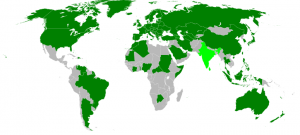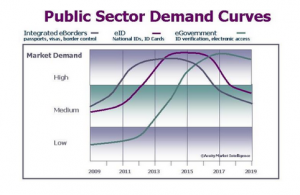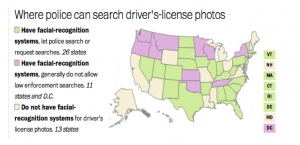Secure Credentialing Industry Report
Z-Square Technology Introduction
Z-Square Technology is a security technology management systems provider. With the development of America’s ID™, Z-Square provides biometric technology, focusing on secure credentialing in government organizations like departments of motor vehicles. This report will be an analysis of the market and future demand for the biometric identification industry.
Product Analysis:
Biometric technology is an advanced technique for the identification of humans, based on their characteristics or traits. These traits can be face, fingerprint, iris, voice, signature, palm, vein, and DNA. The existing methods of human identification such as identification documents and PIN cannot keep up with the growing demand for more rigorous security, which gives a high growth opportunity for the use of biometric technology. Biometric characters cannot be lost, stolen, or easily forged. Iris biometrics has the most significant scope in the near future, due to its high accuracy rate and low false acceptances: between 0.0001% and 0.94%. Signatures, palm, and fingerprints are all considered the least secure as they can be altered and have been tampered with in the past in high-profile government cases. However, the demand for the different types of identification methods do not reflect their accuracy rate.
Current Demand:
Biometric technology was named the second most investable technology in 2013, after Near Field Communications. As demand increases for online banking and mobile payment, the standards for secure credentialing increase as well. According to research by TechCast, 77% of respondents in a survey about biometric ID said biometric technologies are a useful tool for the authentication of identity. 16% liked its scalability, accuracy, security of biometric owners, and ethics. Only 7% were opposed to using biometrics. The technology that respondents most widely accepted was fingerprint recognition (rated 8.15/10), followed by iris recognition (7.9/10). Signature recognition received the lowest acceptance rate (5.72/10)
Demand Projections:
The demand interest of each credentialing type has a different projection and can be analyzed separately. According to the Biometrics Research Group, the global biometrics market will grow to $15 billion by 2015, from its 2012 estimated value of $7 billion. Specifically, the market for automated fingerprint identification systems and fingerprint biometric technologies account for the greatest share of the global biometrics market and is forecast to continue to be the main source of overall market revenues from 2010 to 2015. This sector is valued at $5 billion in 2012 and is expected to reach nearly $10 billion in 2015. Face, iris, vein, and voice recognition biometric technologies together form the second largest segment. This sector is worth an estimated $2 billion in 2010 and is expected to reach $5 billion in 2015.
Demand projections for the Public Sector
Overall demand for Biometric ID differs between the private and public sector. There are three key drivers for public sector demand that Z- Square must consider when targeting public organizations.
1) eGovernment is a fully interactive service delivery for citizens and commercial entities. Post 9/11, terrorist fears and other international border control requirements have increased demand for integrated eBorder solutions worldwide. The initial demand peak has already begun in Europe and the US and will remain in force through 2013. The subsequent demand curve for eID solutions–which benefits from the systems architected for use in integrated eBorders applications–peaks around 2010. Demand for eGovernment will lag sustaining peak demand around 2017 as the authentication implications of large-scale, transactional eGovernment systems are recognized and implemented. As millions of citizens worldwide rely on biometrically enabled ID to travel to identify themselves in various ways, and interact and transact with local, regional and federal governments daily, human-machine authentication will become an integral aspect of 21st century government.
2) Integrated eBorders is the term for the full scope of electronic and automated border control management including travel documents, transportation worker IDs, vehicle access, immigrant Visas and IDs, and expedited passenger systems. Many consider this to be an ideal, international version of eGovernment and a necessity for eGovernment to be adopted worldwide. The availability of Biometric Identification for Integrated eBorders is developed in many countries already as shown below. The dark green shows countries that offer Biometric passports and bright green shows countries that will soon have this option.

3) eID includes national and other identity cards, benefits distribution, voter registration, drivers licenses, and other physical and virtual credentials. In eID, personal identity is secured for organizational and census purposes as well as security of personal finances. As shown in the graph below, eID is currently at an all-time height for growth and will remain so until 2016, when eGovernment is expected to have a larger focus. It does not require as much border control and an ideal eGovernment model, and is therefore less expensive.

Demand Projections for the Private Sector
Commercial market demand will revolve around opportunities for:
1) Enterprise Security – which includes physical and logical access for employees and third parties (customers, vendors, etc.) as well as credentialing and surveillance.
2) Information Transactions – corporate and personal access to travel, financial and healthcare information, business account, supplier and customer information, as well as IP management for technical, scientific and research firms.
3) Financial Transactions – consumer, business to business, ATM, and inter-bank transactions. As security threats multiply and various forms of identity theft, fraud, and abuse schemes proliferate, biometrics will offer an extremely cost-effective and truly reliable alternative to more traditional and less secure and convenient forms of authentication.

Major Industry Players in Civil ID Credentialing:
Biometric companies have been receiving more news attention in recent years due to acquisitions and an intense fight for competitive advantage in their respective credentialing focuses. The French defense company Safran completed the acquisition of the biometric solution provider L-1 Identity Solutions in Q2 2011 for US$1 billion. The acquisition helped Safran become a leading player in the global biometric readers market. Similarly, 3M completed the acquisition of Cogent Inc. in December 2010 for US$943 million.
Safran: offers a complete range of security solutions covering three main market segments: identification, secure documents and detection. With the recent acquisitions of GE Homeland Protection, Printrak and L-1 Identity Solutions, they use multibiometric identification technologies for eGovernment and eID systems including explosive detection systems and smart cards, which means that it can address emerging security requirements for individuals, businesses and countries. Deployed in more than 100 countries worldwide.
3M Cogent: Provides identity management solutions and biometric access control products to governments, law enforcement agencies, and commercial customers worldwide. They have established a reputation for successful deployment of cost-effective finger, face, and iris biometric systems for voting, asylum seekers, citizen benefits, identity credentialing, driver licenses, law enforcement, criminal investigations, border security, and others.
3M Cogent: Provides identity management solutions and biometric access control products to governments, law enforcement agencies, and commercial customers worldwide. They have established a reputation for successful deployment of cost-effective finger, face, and iris biometric systems for voting, asylum seekers, citizen benefits, identity credentialing, driver licenses, law enforcement, criminal investigations, border security, and others.

37 states now use secure credentialing in the form of facial recognition technology in their driver’s-license registries-recognition. Systems are more pervasive and can be deployed remotely, without subjects knowing that their faces have been captured. Today’s driver’s-license databases, which also include millions of images of people who get non-driver ID cards to open bank accounts or board airplanes, typically were made available for police searches with little public notice. At least 26 of those allow state, local or federal law enforcement agencies to search — or request searches — of photo databases.
While citizens can be wary of this information being held, it has become a necessity for organization and homeland security reasons in the past decade. The current version of the Immigration Bill has also created a huge demand for an electronic photo-verification system or any biometric ID, starting with departments of motor vehicles. Driver’s license photographs and biographic information of most Americans will soon be accessible through an expanded Department of Homeland Security nationwide.
Conclusion
The future of biometrics looks increasingly bright with the demand for security rising daily. As noted by TechCast, biometrics is growing exponentially at a rate of 35% annually. Z-square technology is in the second most important and growing tech industry for the coming years and must compete with huge firms that have much more capital, but because secure credentialing is becoming necessary in so many fields, it will be easy to find a target market.
Sources:
Organization blog: http://blog.aamva.org/
Organization website: www.aamva.org
Article: http://www.theblaze.com/stories/2013/06/17/say-cheese-some-states-put-drivers-license-photos-in-facial-recognition-database-for-law-enforcement-use/
Article: http://www.safran-group.com/site-safran-en/finance-397/financial-publications/financial-press-releases/article/safran-completes-the-acquisition-11359
Article: http://www.biometricupdate.com/biometric-companies
Article: http://www.biometricupdate.com/service-directory/civil-id
Company Directory: http://findbiometrics.com/companies/
Study: http://www.techcast.org/Upload/PDFs/634122830612738824_Biometrics-VivianandGayathrilo-res.pdf
Image sources:
1) http://en.wikipedia.org/wiki/File:Map_of_countries_with_biometric_passports.svg
2)http://www.acuity-mi.com/ID_Solutions_Demand_Curves.php
3)http://www.acuity-mi.com/ID_Solutions_Demand_Curves.php
4)http://www.washingtonpost.com/business/technology/state-photo-id-databases-become-troves-for-police/2013/06/16/6f014bd4-ced5-11e2-8845-d970ccb04497_story.html




